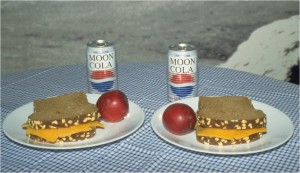Thanksgiving on the Moon: A Lunar Feast
Although the Moon is certainly different from the Earth, it is hardly barren.

We often hear the Moon described as a lifeless desert, a barren rock in space where nothing can survive. Although the Moon is certainly different from the Earth, it is hardly barren. From the 1970’s through the 1990’s (largely before we knew about the presence of water and other volatiles in the lunar polar regions) the late, lunar scientist Dr. Larry Haskin set forth some basic facts about the chemical composition of the Moon. Larry was a chemist by training and his view was that the Moon has all that we need – just not in the form in which we need it.
Larry wrote a very interesting paper for the 1988 Second Symposium on Lunar Bases. Over the years, I heard him give several different versions of this talk. Initially, he called it “Wine and Cheese from the Lunar Desert” but after deciding that he didn’t want to drive away or offend any teetotalers in his audience, he changed it, first to “Cola and Cheese” and then “Water and Cheese from the Lunar Desert.” Although the liquid varied, the cheese stayed.
Haskin’s argument is very simple. Take a cubic volume of soil (about 1 meter in dimension) from anywhere on the Moon. In that volume of soil (weight about 1600 kg), there is enough hydrogen, carbon, and nitrogen – the principal volatile elements implanted by the solar wind – to make lunch for two. Larry’s menu was modest, but satisfying: two cheese sandwiches, two glasses of wine (or cola, with real sugar), and two plums. Chemical atoms needed to make up this meal are all present in that relatively small volume of soil; they are just not arranged in the form that we need them. But the task is possible, given time and energy.
Because the Moon has no atmosphere and no global magnetic field, the highly energetic stream of particles from the Sun (the solar wind) implants its atoms directly onto the dust grains of the soil. This material is mostly hydrogen and helium, but other light atoms such as carbon, nitrogen and other noble gases are also present. These volatile elements seem to correlate with a property called “maturity” which means the amount of time a soil has been exposed to the space environment. The amount of solar wind gas also correlates inversely with grain size – the finest fraction of the soil contains the most solar wind. Another unusual correlation is with titanium; the highest quantities of solar wind hydrogen are found in very high titanium soils. It’s not clear why this should be true, although it is postulated that the crystal structure of ilmenite (an iron- and titanium-oxide mineral) acts as a “sponge” for solar wind atoms.
Given these properties, the best soil on the Moon to process and extract these important volatile substances would be very fine-grained, high-titanium soils. In fact, this soil occurs as the dark pyroclastic ash that sometimes covers mare and highlands areas on the Moon. They are very fine-grained (typical mean grain sizes of a few tens of microns) and some are rich in titanium. The tiny black glass beads returned by the Apollo 17 mission have up to 13 wt.% titanium dioxide (among the highest found on the Moon). However, these Apollo 17 samples were buried by a landslide for millions of years so we do not know how much volatile material a mature, exposed surface ash deposit might contain. A robotic mission to such an area to measure the amount of solar wind gas could answer these questions.
Extracting the volatiles from soil is very simple: just heat the soil to about 700° C. Although simple in concept, in practice this may be a very difficult job. We need to find a way to process the lunar soil in a continuous stream. Batch processing is much less efficient and expensive. Soil roasters that continuously roam the surface, heating the soil using solar thermal power and collecting and storing the emitted gas, is likely to be at least part of the ultimate solution.
During recent discussions about using lunar polar ice, some expressed concern that we would too rapidly devour what they perceive to be a limited resource. Although the Moon has hundreds of millions of tones of water around the poles, ultimately, we will need to learn how to use the lower grade ore present elsewhere around the globe. In this case, it will be the bountiful lunar regolith – the meters-thick outer layer of the Moon. This resource can truly last a lifetime – the lifetime of humanity in space. Wine and cheese (or beer or cola and cheese, if you prefer) is there for the taking and the making. We are limited not by the intrinsic resources of the Moon but only by our own imaginations.
Something else to be thankful for this season—a Moon that has what we need to survive and thrive in space.
/https://tf-cmsv2-smithsonianmag-media.s3.amazonaws.com/accounts/headshot/blog_headshot_spudis-300x300.jpg)
/https://tf-cmsv2-smithsonianmag-media.s3.amazonaws.com/accounts/headshot/blog_headshot_spudis-300x300.jpg)